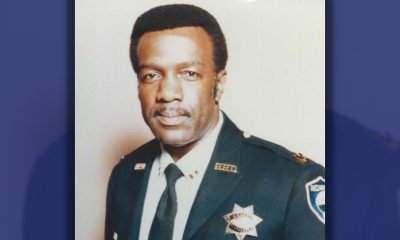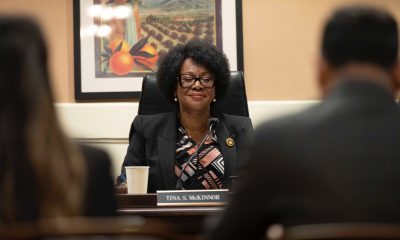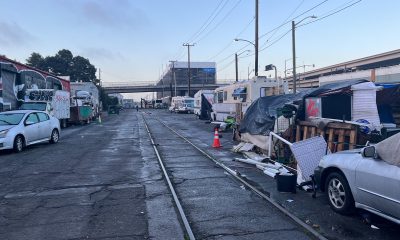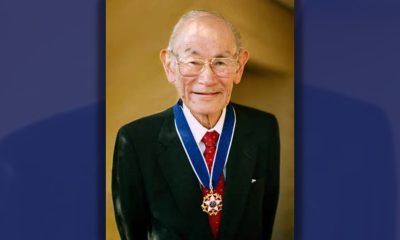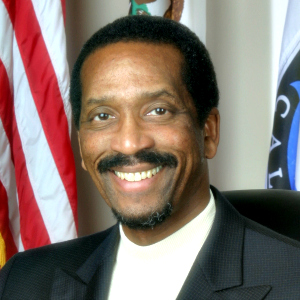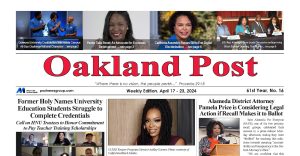Activism
Slashing Greenhouse Gases: California Revises Strategy for Climate Change
“The Air Resources Board’s latest climate plan once again pins California’s future on a dangerous carbon capture pipe dream,” said Jason Pfeifle, a senior climate campaigner at the Center for Biological Diversity. “Caving to polluters who want to keep burning fossil fuels and dirty biomass energy is a one-way ticket to climate destruction. California needs a plan that rejects industry scams, preserves our ecosystems, and rapidly phases out fossil fuels.”

By Nadia Lopez, CalMatters
The California Air Resources Board unveiled a new version of its highly anticipated strategy for battling climate change on Nov. 16, setting more ambitious targets for cutting greenhouse gases and scaling up controversial projects that capture carbon.
If adopted by the air board at its Dec. 15 meeting, the plan would radically reshape California’s economy, alter how Californians’ vehicles, buildings and appliances are powered, and ultimately serve as a blueprint for other states and countries to follow.
“Failure is not an option,” said air board Chair Liane Randolph. “There is too much at stake and we need to move as fast and as far as we can to lessen the worst impacts of climate change and leave future generations a livable and healthy California.”
The five-year climate change strategy, called a scoping plan, outlines in its 297 pages how California could end its reliance on oil and also clean up the nation’s worst air pollution.
The staff’s final draft plan adds bolder commitments, reducing oil use by 94% from 2022 levels by 2045 — up from a goal of 91% in the September version of the plan.
The plan also sets a more aggressive goal of cutting carbon emissions 48% below 1990 levels by 2030 — up from the 40% by 2030 required under state law. Net-zero emissions would be achieved in 2045. (Net-zero or carbon neutrality means striking a balance between the carbon dioxide added to the air and the carbon that’s removed.)
California has a long way to go to meet the new 48% goal in just eight years. By 2020 it had cut emissions only about 14% below 1990 levels, according to air board officials.
Danny Cullenward, a climate economist who serves on a committee advising the state about its system for trading greenhouse gas credits, said California isn’t on track to meet its existing 2030 reduction target, much less the new, more stringent goal.
“I don’t want to say California isn’t doing anything on climate. We’ve done a lot of things,” said Cullenward, who serves on the Independent Emissions Market Advisory Committee. “But this is such a superficial exercise and it’s filled with so many faults and errors.”
Air board officials, however, said they are confident that the state can achieve the new target, largely with mandates and policies enacted this year. State officials phased out sales of new gas-powered cars by 2035, set a more stringent low-carbon fuel standard and streamlined siting and permitting of renewable energy projects.
“This plan is a comprehensive roadmap to achieve a pollution-free future,” Gov. Gavin Newsom said in a statement. “It’s the most ambitious set of climate goals of any jurisdiction in the world, and, if adopted, it’ll spur an economic transformation akin to the industrial revolution.”
But Cullenward criticized the staff’s modeling, which is used to predict how each sector of the economy will reduce emissions. He said the plan lacks a thorough analysis of the feasibility of its projections and makes major assumptions.
One example, he said, is that the plan relies on other agencies, such as the California Energy Commission, setting new policies, but it doesn’t address the timing and roadblocks they may face or other details.
“It’s a pretty aspirational document but it’s filled with bureaucratic doublespeak,” he said. “It’s really frustrating because there’s so much work to be done.”
Some policy experts say setting ambitious goals is a crucial step toward cleaning up air pollution and combating climate change.
“The scoping plan can at least help us direct our attention even if it doesn’t give us as much detail as we want,” said Dave Weiskopf, senior policy advisor with NextGen Policy, a progressive advocacy group. “On the one hand, that is really frustrating. On the other hand, it tells us that if we put in the effort to say what we think a good plan should look like, we at least have a shot of getting the state to take meaningful action.”
The new plan relies more than the original versions on two controversial, advanced technologies for eliminating planet-warming carbon dioxide. Combined, 15% — increased from 5% — of all of the state’s targeted greenhouse gas cuts will come from carbon removal and carbon capture and storage.
One strategy removes carbon from the atmosphere, such as replanting trees or storing it in soils. Another, called carbon capture and storage, collects carbon spewed from industry smokestacks and injects it into the ground.
California currently has no carbon removal or capture and storage projects, and air board officials say they wouldn’t be deployed until 2028. The state’s scenario predicts that carbon-capture technology will be installed on most of California’s 17 oil refineries by 2030 and on all cement, clay, glass, and stone facilities by 2045.
Environmental groups oppose both technologies, saying they extend the lives of fossil fuels, while oil companies say they are necessary to achieve the state’s long-term climate goals. The debate pits those who want to mandate an end to fossil fuels against those who want an approach that relies somewhat on technology to clean up carbon.
Globally, 27 carbon capture and storage projects are operating so far.
Oil industry officials declined to comment on the plan Wednesday.
Achieving the plan’s targets would cost $18 billion in 2035 and $27 billion in 2045, according to air board estimates. The move to decarbonize and transition away from fossil fuels will also drastically increase electricity use, which is expected to soar by as much as 68% in 2045.
At Newsom’s direction, the air board in September already strengthened its draft plan, originally released last May, to include new goals for offshore wind, cleaner aviation fuels and reducing vehicle miles traveled.
Other changes include constructing 3 million climate-friendly homes by 2030 and 7 million by 2035, installing at least 6 million heat pumps by 2030, and eliminating the option of building new natural gas plants or using fossil fuels in the electricity sector to maintain grid reliability.
Eliminating 100 million tons of carbon
Under a new law that Newsom prioritized in his climate package at the end of this year’s legislative session, the air board was directed to create a new program that puts guardrails on carbon capture, use and storage projects while streamlining the permitting process.
These technologies aim to remove or capture and store at least 20 million metric tons of carbon by 2030 and 100 million metric tons by 2045, according to the plan.
Once captured from smokestacks, the carbon could be transported to sites in the Central Valley. Air board staff say the valley is an ideal location for injecting carbon dioxide deep into rock formations because it has the capacity to store at least 17 billion tons.
Though controversial, air board staff say the technologies are a “necessary tool” to reduce emissions from industrial sectors, such as the cement industry, where no other alternatives may exist.
“We’ve squeezed out all of the emissions that we can under the inventory for manufacturing for transportation and for industry, but we know residual emissions will remain,” said Rajinder Sahota, the board’s deputy executive officer for climate change and research. “We’re going to need all the tools in all of these categories.”
But at an Oct. 28 workshop, members of the state’s Environmental Justice Advisory Committee raised several concerns about engineered carbon removal, saying it is an unproven strategy that could continue to plague local communities with air pollution. They also say it would delay closure of oil facilities and act as a substitute for direct emissions reductions.
“The Air Resources Board’s latest climate plan once again pins California’s future on a dangerous carbon capture pipe dream,” said Jason Pfeifle, a senior climate campaigner at the Center for Biological Diversity. “Caving to polluters who want to keep burning fossil fuels and dirty biomass energy is a one-way ticket to climate destruction. California needs a plan that rejects industry scams, preserves our ecosystems, and rapidly phases out fossil fuels.”
Air board staff acknowledged these concerns, but Randolph, the board’s chair, said many of the greenhouse gas targets could not be achieved without them. She said the board has prioritized creating a metric to measure how residents could be affected by these projects and also consider the needs of people who are most affected by air pollution.
Randolph said the plan’s heavy emphasis on cutting emissions from transportation will also significantly improve air quality in vulnerable communities. Cutting vehicle miles traveled and improving access to mass transit, designing more pedestrian-friendly neighborhoods and increasing access to electric bikes and vehicles all play a role.
The board expects the state’s landmark cap and trade program — which allows big polluters to buy credits to offset their greenhouse gas emissions — to play a much smaller role over time.
In the 2017 version of their scoping plan, air board officials estimated about 38% of emissions reductions would come from cap and trade. Instead, it now would help “fill the gap” to meet the accelerated 2030 emissions target.
Cap and trade has been heavily criticized by legislators and experts in recent years. One criticism is that there are at least 310 million unused credits currently in the system, which is a problem because companies hoard credits that allow them to keep polluting past state limits in later years. Air board officials say they hope to reform the program and address the oversupply of credits at the end of next year.
Activism
Oakland Post: Week of April 17 – 23, 2024
The printed Weekly Edition of the Oakland Post: Week of April 17 – 23, 2024

To enlarge your view of this issue, use the slider, magnifying glass icon or full page icon in the lower right corner of the browser window. ![]()
Activism
Oakland Schools Honor Fred Korematsu Day of Civil Liberties
Every Jan. 30, OUSD commemorates the legacy of Fred Korematsu, an Oakland native, a Castlemont High School graduate, and a national symbol of resistance, resilience, and justice. His defiant stand against racial injustice and his unwavering commitment to civil rights continue to inspire the local community and the nation. Tuesday was “Fred Korematsu Day of Civil Liberties and the Constitution” in the state of California and a growing number of states across the country.

By Post Staff
Every Jan. 30, OUSD commemorates the legacy of Fred Korematsu, an Oakland native, a Castlemont High School graduate, and a national symbol of resistance, resilience, and justice.
His defiant stand against racial injustice and his unwavering commitment to civil rights continue to inspire the local community and the nation. Tuesday was “Fred Korematsu Day of Civil Liberties and the Constitution” in the state of California and a growing number of states across the country.
One OUSD school is named in his honor: Fred T. Korematsu Discovery Academy (KDA) elementary in East Oakland.
Several years ago, founding KDA Principal Charles Wilson, in a video interview with anti-hate organization “Not In Our Town,” said, “We chose the name Fred Korematsu because we really felt like the attributes that he showed in his work are things that the children need to learn … that common people can stand up and make differences in a large number of people’s lives.”
Fred Korematsu was born in Oakland on Jan. 30, 1919. His parents ran a floral nursery business, and his upbringing in Oakland shaped his worldview. His belief in the importance of standing up for your rights and the rights of others, regardless of race or background, was the foundation for his activism against racial prejudice and for the rights of Japanese Americans during World War II.
At the start of the war, Korematsu was turned away from enlisting in the National Guard and the Coast Guard because of his race. He trained as a welder, working at the docks in Oakland, but was fired after the bombing of Pearl Harbor in 1941. Fear and prejudice led to federal Executive Order 9066, which forced more than 120,000 Japanese Americans out of their homes and neighborhoods and into remote internment camps.
The 23-year-old Korematsu resisted the order. He underwent cosmetic surgery and assumed a false identity, choosing freedom over unjust imprisonment. His later arrest and conviction sparked a legal battle that would challenge the foundation of civil liberties in America.
Korematsu’s fight culminated in the Supreme Court’s initial ruling against him in 1944. He spent years in a Utah internment camp with his family, followed by time living in Salt Lake City where he was dogged by racism.
In 1976, President Gerald Ford overturned Executive Order 9066. Seven years later, the 9th Circuit Court of Appeals in San Francisco vacated Korematsu’s conviction. He said in court, “I would like to see the government admit that they were wrong and do something about it so this will never happen again to any American citizen of any race, creed, or color.”
Korematsu’s dedication and determination established him as a national icon of civil rights and social justice. He advocated for justice with Rosa Parks. In 1998, President Bill Clinton gave him the Presidential Medal of Freedom saying, “In the long history of our country’s constant search for justice, some names of ordinary citizens stand for millions of souls … To that distinguished list, today we add the name of Fred Korematsu.”
After Sept. 11, 2001, Korematsu spoke out against hatred and discrimination, saying what happened to Japanese Americans should not happen to people of Middle Eastern descent.
Korematsu’s roots in Oakland and his education in OUSD are a source of great pride for the city, according to the school district. His most famous quote, which is on the Korematsu elementary school mural, is as relevant now as ever, “If you have the feeling that something is wrong, don’t be afraid to speak up.”
Activism
WOMEN IMPACTING THE CHURCH AND COMMUNITY
Juanita Matthews, better known as “Sister Teacher,” is a walking Bible scholar. She moved to California from the great state of Arkansas in 1971. Sister Teacher has a passion for teaching. She has been a member of Bible Fellowship Missionary Baptist Church since 1971.

Sister Juanita Matthews
55 Years with Oakland Public School District
The Teacher, Mother, Community Outreach Champion, And Child of God
Juanita Matthews, better known as “Sister Teacher,” is a walking Bible scholar. She moved to California from the great state of Arkansas in 1971. Sister Teacher has a passion for teaching. She has been a member of Bible Fellowship Missionary Baptist Church since 1971. She followed her passion for teaching, and in 1977 became the lead teacher for Adult Class #6. Her motto still today is “Once My Student, Always My Student”.
Beyond her remarkable love for the Lord, Sister Teacher has showcased her love for teaching by working for the Oakland Unified School District for 55 years, all but four of those years spent at Emerson Elementary and Child Development School. She truly cares about her students, making sure they have the tools/supplies needed to learn either at OUSD or Bible Fellowship Missionary Baptist Church.
She’s also had a “Clothes Closet Ministry” for 51 years, making sure her students have sufficient clothing for school. The Clothes Closet Ministry extends past her students, she has been clothing the community for over 50 years as well. She loves the Lord and is a servant on a mission. She is a loving mother to two beautiful children, Sandra and Andre. This is the impact this woman of God has on her church and the community.
-
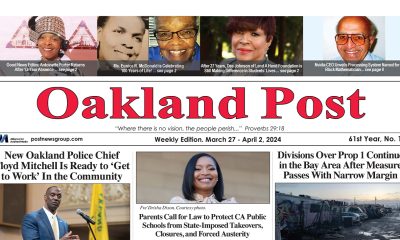
 Activism4 weeks ago
Activism4 weeks agoOakland Post: Week of March 27 – April 2, 2024
-
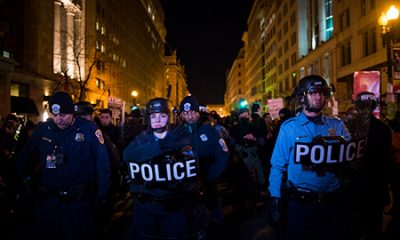
 #NNPA BlackPress4 weeks ago
#NNPA BlackPress4 weeks agoCOMMENTARY: D.C. Crime Bill Fails to Address Root Causes of Violence and Incarceration
-

 #NNPA BlackPress4 weeks ago
#NNPA BlackPress4 weeks agoMayor, City Council President React to May 31 Closing of Birmingham-Southern College
-

 #NNPA BlackPress4 weeks ago
#NNPA BlackPress4 weeks agoBeloved Actor and Activist Louis Cameron Gossett Jr. Dies at 87
-
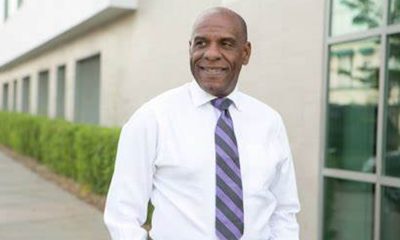
 Community1 week ago
Community1 week agoFinancial Assistance Bill for Descendants of Enslaved Persons to Help Them Purchase, Own, or Maintain a Home
-
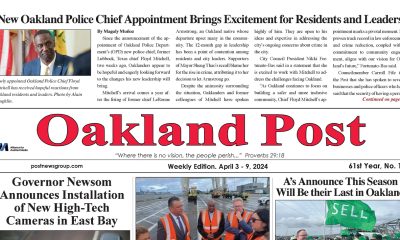
 Activism3 weeks ago
Activism3 weeks agoOakland Post: Week of April 3 – 6, 2024
-

 Business1 week ago
Business1 week agoV.P. Kamala Harris: Americans With Criminal Records Will Soon Be Eligible for SBA Loans
-
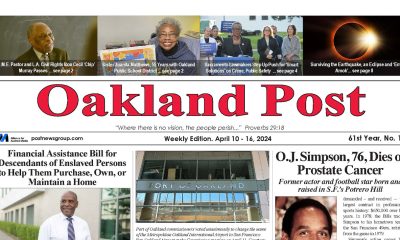
 Activism2 weeks ago
Activism2 weeks agoOakland Post: Week of April 10 – 16, 2024



